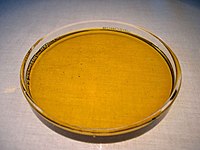Neem oil, also known as margosa oil, is a vegetable oil pressed from the fruits and seeds of the neem (Azadirachta indica), a tree which is indigenous to the Indian subcontinent and has been introduced to many other areas in the tropics. It is the most important of the commercially available products of neem, and its chemical properties have found widespread use as a pesticide in organic farming.

Composition
editAzadirachtin is the most well known and studied triterpenoid in neem oil. Nimbin is another triterpenoid which has been credited with some of neem oil's properties as an antiseptic, antifungal, antipyretic and antihistamine.[1]
Uses
editAyurveda
editNeem oil has a history of use in Ayurvedic folk medicine.[2][3]
Toxicity
editThe ingestion of neem oil is potentially toxic and can cause metabolic acidosis, seizures, kidney failure, encephalopathy and severe brain ischemia in infants and young children.[2][4][5] Neem oil should not be consumed alone without any other solutions, particularly by pregnant women, women trying to conceive or children.[2] It can also be associated with allergic contact dermatitis.[6]
Pesticide
editFormulations that include neem oil have found wide usage as a biopesticide for horticulturists[7] and for organic farming, as it repels a wide variety of insect pests including mealy bugs, beet armyworms, aphids, cabbage worms, thrips, whiteflies, mites, fungus gnats, beetles, moth larvae, mushroom flies, leaf miners, caterpillars, locusts, nematodes and Japanese beetles.[8][9]
When sufficiently dilute and not concentrated directly into their area of habitat or on their food source, neem oil is not known to be harmful to mammals, birds, earthworms or some beneficial insects such as butterflies, honeybees and ladybugs. It can be used as a household pesticide for ants, bedbugs, cockroaches, houseflies, sand flies, snails, termites and mosquitoes both as a repellent and as a larvicide.[3]
Neem extracts act as an antifeedant and block the action of the insect molting hormone ecdysone. Azadirachtin is the most active of these growth regulators (limonoids), occurring at 0.2–0.4% in the seeds of the neem tree.[10]
References
edit- ^ W. Kraus, "Biologically active ingredients-azadirachtin and other triterpenoids", in: H. Schutterer (Ed.), The Neem Tree Azadirachta indica A. Juss and Other Meliaceous Plants, Weinheim, New York, 1995, pp. 35–88.
- ^ a b c "Neem Oil Monograph". Drugs.com. Archived from the original on 16 March 2018. Retrieved 26 January 2016.
- ^ a b Puri, H. S. (1999). Neem: The Divine Tree. Azadirachta indica. Amsterdam: Harwood Academic Publications. ISBN 978-90-5702-348-4.
- ^ Meeran, M; Murali, A; Balakrishnan, R; Narasimhan, D (November 2013). ""Herbal remedy is natural and safe"--truth or myth?". The Journal of the Association of Physicians of India. 61 (11): 848–50. PMID 24974507.
- ^ Bhaskar, MV; Pramod, SJ; Jeevika, MU; Chandan, PK; Shetteppa, G (August 2010). "MR imaging findings of neem oil poisoning". AJNR. American Journal of Neuroradiology. 31 (7): E60-1. doi:10.3174/ajnr.A2146. PMC 7965469. PMID 20448012.
- ^ de Groot, A; Jagtman, BA; Woutersen, M (2017). "Contact Allergy to Neem Oil". Dermatitis: Contact, Atopic, Occupational, Drug. 28 (6): 360–362. doi:10.1097/DER.0000000000000309. PMID 29059091. S2CID 39042581.
- ^ Emken, Tyler (25 October 2019). "Office of Sustainability interns work to heal beloved Fell Arboretum tree". Illinois State University. Archived from the original on 24 June 2021. Retrieved 17 June 2021.
- ^ Isman, Murray B (2006). "Botanical Insecticides, Deterrents, and Repellents in Modern Agriculture and an Increasingly Regulated World". Annual Review of Entomology. 51: 45–66. doi:10.1146/annurev.ento.51.110104.151146. PMID 16332203.
- ^ Mishra, A. K; Singh, N; Sharma, V. P (1995). "Use of neem oil as a mosquito repellent in tribal villages of mandla district, madhya pradesh". Indian Journal of Malariology. 32 (3): 99–103. PMID 8936291.
- ^ Robert L. Metcalf (2007), "Insect Control", Ullmann's Encyclopedia of Industrial Chemistry (7th ed.), Wiley, pp. 1–64, doi:10.1002/14356007.a14_263, ISBN 978-3527306732